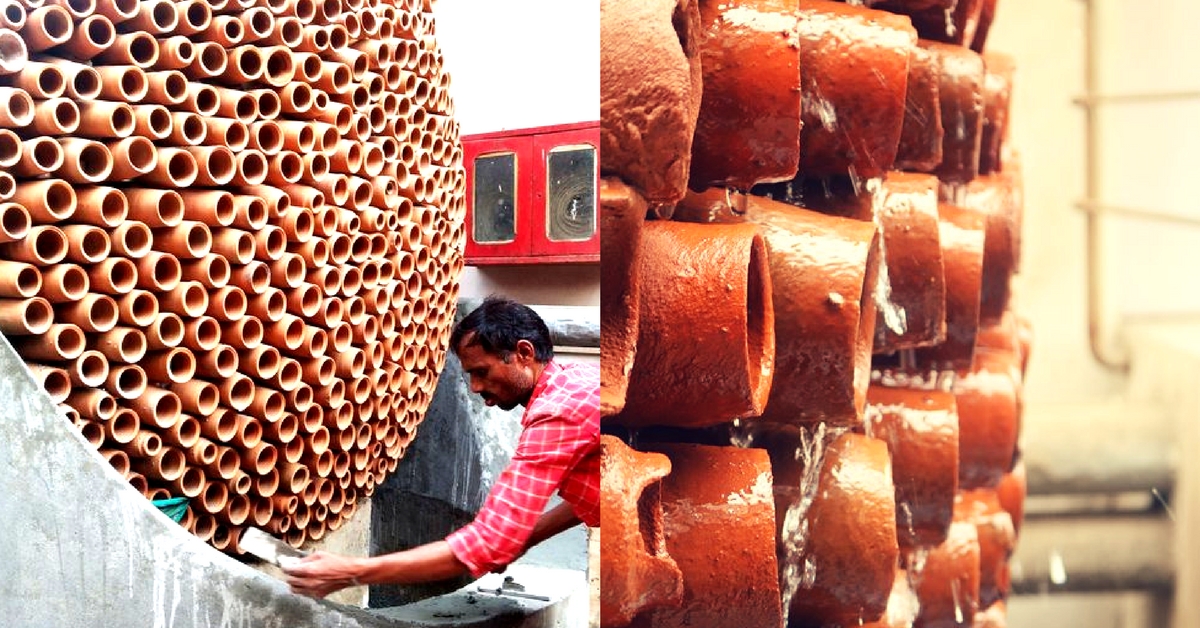One is no stranger to the blistering heat in India during the summers. While it doesn’t take much for one to switch the air conditioner on, the repercussions on the environment are huge, and affordability is another factor in question.
In the grand scheme of things, Delhi-based Ant Studio, has designed a low-energy and cost-efficient air conditioning system.

The idea took inception as a design solution for the workers at the factory of Deki Electronics in Uttar Pradesh, where scorching heat released from the Genset at the entrance in the external area of the factory, was taking a toll on the health of the employees and reducing productivity.
Currently stationed at the external driveway of the factory, this low-energy and cost-efficient air conditioning system looks more like an art installation. It is an elaborate arrangement of hundreds of cone-shaped terracotta pots into a beehive patterned circle.
The cooling technique traces back to traditional Egyptian evaporative cooling methods. It facilitates cooling down surroundings with the help of water and local materials. The thrust of hot air from the genset is used to facilitate cooling using a fan mechanism.
This evaporative cooling system starts after just after water recycled from the factory at room temperature is poured onto the elaborate structure of cylindrical terracotta tubes using a motor.
“The porous terracotta pots absorb water, and as hot air passes through them, it’s turned into cool air. All the tubes are also surrounded with sand to hold water for longer,” explains Homecrux.
The installed prototype was able to cool down a temperature of 50 degrees Celsius to 36 degrees Celsius with the air flow recorded at 4m/sec.
Each of the tubes is precisely designed using computational analysis to determine the exact measurements of the thickness of the cones walls.
The idea is to get as much surface area as possible for evaporation to take place. Since terracotta is inexpensive, the model can be easily scaled up and replicated.
Read more: ‘Seed Mother’ Rahibai’s Story: How She Saved Over 80 Varieties of Native Seeds!
The model can be built anywhere, in remote locations with a consistent electrical grid. But in regions that suffer a shortage of power supply, the model can work as a zero-energy installation with the manual pouring of water over the pots. But it isn’t recommended in the long run.
In an interview with Arch Daily, Monish explained, “I believe this experiment worked quite well functionally. Findings from this attempt opened up a lot more possibilities where we can integrate this technique with forms that could redefine the way we look at cooling systems, a necessary yet ignored component of a building’s functionality. Every installation could be treated as an art piece.”
The Delhi based architectural firm hopes to scale and replicate this design in factories across India. Once scaled and multiplied, it will help generate not only low-cost, eco-friendly air conditioning but also help local potters earn more.
Visit Ant Studio here.
Like this story? Or have something to share?
Write to us: contact@thebetterindia.com
Connect with us on Facebook and Twitter.
NEW: Click here to get positive news on WhatsApp!
If you found our stories insightful, informative, or even just enjoyable, we invite you to consider making a voluntary payment to support the work we do at The Better India. Your contribution helps us continue producing quality content that educates, inspires, and drives positive change.
Choose one of the payment options below for your contribution-
By paying for the stories you value, you directly contribute to sustaining our efforts focused on making a difference in the world. Together, let's ensure that impactful stories continue to be told and shared, enriching lives and communities alike.
Thank you for your support. Here are some frequently asked questions you might find helpful to know why you are contributing?

